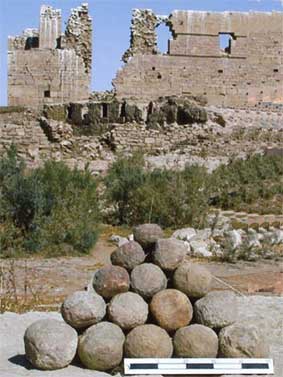Roman Artillery Balls from Qasr Ibrim, Egypt |
Alan Wilkins, Hans Barnard and Pamela J. Rose | |
|
"The Ethiopians who extend towards the south and Meroe are not many in number and are a scattered population because they inhabit a long, narrow, winding river bank. They are not well prepared for warfare or for any other kind of life." (Strabo 17.1.53). Strabo's dismissive remarks are disproved by the bold and successful Meroitic attack on the Roman three-cohort garrison at Syene (Aswan) during the absence of Aelius Gallus on his campaign in Arabia in 25/24 BC.. The Ethiopians struck unexpectedly, capturing Syene, Elephantine and Philae, enslaving the inhabitants, and pulling down the statues of Caesar Augustus. In retaliation the Roman governor Petronius set out with fewer than 10,000 infantry, and 800 cavalry, and forced them to withdraw to Pselchis (Dakka). Asked by Petronius' envoys why they had begun a war, they said they had been unjustly treated by the Nomarchs, the tax collectors (Torok 1997, 452). They probably repeated such complaints some three years later to Augustus when they met him on Samos (Strabo 17.1.54). Petronius forced them out to battle and routed them "because their battle lines were poorly drawn up and they were poorly armed" During the ensuing pursuit he captured "the
generals of Queen Kandake, the ruler of the Ethiopians in our day,
a masculine sort of woman, blind in one eye". After taking
Pselchis, he then "reached Premnis [Qasr Ibrim],
a fortified city, taking it at the first attempt" |
||

A group of the heavy balls (scale in 10cm increments).